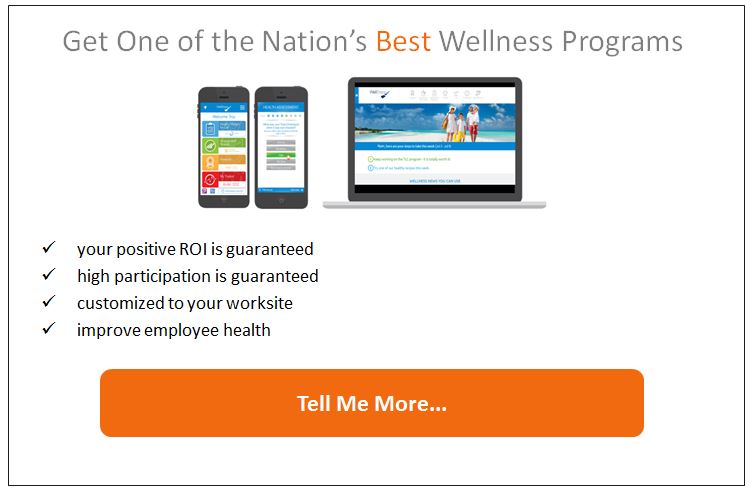Wouldn’t it be great if cities operated like beehives? Where the workers didn’t simply know their role but understood its importance, strived for efficiency, and seemed rather content doing it? Theoretically, this is the model most of us strive for, but the reality of the demands and stresses of life make this hard. We’re going to show you why city wellness programs build better communities.

When employees are stressed, unhealthy, and mentally taxed, it often extrapolates burdens they face outside the office, making their work responsibilities overwhelming, often leading to decreased efficiency and presenteeism, and increased absences.
Related: What Is Workplace Wellness? A Complete Guide
Why City Wellness Programs Build Better Communities
Have you ever contemplated all that goes into managing a city? Cities and other similar municipalities manage everything from enforcing state laws and collecting taxes to assessing properties and conducting elections.
- parks and libraries
- sewers and emergency management
- service highways
- provide police and fire protection
- oversee planning and zoning
The decisions and actions, or lack thereof, by government officials have a profound impact on their communities. Keeping the people that run our cities healthy and happy is a smart way to keep those impacts positive.
These individuals are responsible for teaching our children, caring for us when we’re ill, assisting us in times of need, and providing services that enrich our lives. If we desire a happy and productive community, we must ensure that those managing these responsibilities receive the support they need from the cities they serve.
“Healthy employees not only have a better quality of life, they also benefit from having a lower risk of disease, illness, and injury, as well as increased work productivity and a greater likelihood of contributing to their communities.” CDC.com
How City Wellness Programs Build Better Communities
Boosts Morale
Encouraging employees to care about their health and providing them access to healthcare will help them feel better, and when people feel better, they’re more inclined to connect and positively contribute to their teams, customers, and communities.

If the Great Resignation has taught us anything, it’s that workers want to feel cared about. Keeping a person’s overall wellness at the forefront of an employer’s goals is a great way to confirm their value on an individual level. Cities need good people in place, and aiming for high employee morale will help public employees want to stick around.
RELATED: 16 Workplace Health and Well-being Ideas, Activities, and Initiatives for Any Budget
Increases Productivity
Managing any type of government is complicated and often time-sensitive, making productivity essential (remember that whole essential worker part of the pandemic), and by providing employees access to services designed to improve all areas of their health can help them perform the important work they do through city wellness programs.
The CDC website states that “the net effect is that U.S. employers lose more than $225 billion each year in productivity due to employee health problems.” However, this is based on information dating back to 2003.
A 2018 study from the Integrated Benefits Institute (IBI), a nonprofit health and productivity research organization, found that “US employers paid nearly $880 billion in health care benefits for employees and dependents. However, illness-related lost productivity costs them another $530 billion per year.”
Cities vastly range in size and population, and their offices could have hundreds of workers or only just a few depending on the geographical location. Employee absences cause significant issues in any business, but for the regions managed under limited staffing and funding, a serious health setback of an employee could have a significant impact on a community.
RELATED: 9 Workplace Well-Being Activities to Skyrocket Employee Productivity
Reduces Health Risks
The best way to combat health problems is to prevent them before they start. However, not all health risks are avoidable, and early detection is vital for managing chronic conditions.
Offering a variety of health resources to employees ensures they have the tools to take proactive steps toward their well-being. Additionally, fostering a culture of encouragement and leading by example underscores the importance of good health and highlights the value of utilizing county wellness programs.
RELATED: 10 Ways to Promote Health and Wellness Topics for Employees
Lowers Health Care Costs
In addition to mitigating health risks, another significant advantage is the reduction in healthcare expenses. Annual physicals, dental exams, and screenings provide valuable insights into one’s health status.

Individuals with access to healthcare and who use it for regular check-ups generally experience better overall health. Moreover, routine screenings, including eye exams and dental cleanings, play a crucial role in early prevention.
Did you know? Eye exams are so much more than vision tests. Eyes are a live look into the action of blood vessels and many early signs of diseases appear in them.
Think twice before skipping that eye exam. The American Academy of Ophthalmology has identified 22 diseases that show early symptoms simply in eye exams.
- Aneurysm
- Brain Tumor
- Blood, Tissue, and Skin Cancer
- Diabetes
- Giant Cell Arteritis
- Heart Disease
- High Blood Pressure
- High Cholesterol
- Lupus
- Lyme Disease
- Medication Toxicities
- Multiple Sclerosis
- Myasthenia Gravis
- Rheumatoid Arthritis
- Sarcoidosis
- Sexually Transmitted Diseases
- Sickle Cell Disease
- Sjogren’s syndrome
- Stroke
- Thyroid Disease
- Vascular Disease
- Vitamin A Deficiency
Better Recruitment and Retention
Similar to businesses, cities thrive when they prioritize recruitment and retention. It’s not just about finding the right person; it’s about retaining them long enough for their skills to make a meaningful impact.
Recruitment is a complex and time-consuming process. From defining the new role accurately for job postings to reviewing resumes, conducting interviews, and extending offers, it’s a multifaceted endeavor.
Once the top candidate is onboard, losing them would mean restarting the entire process, not to mention the training involved. However, retaining the right talent requires more than just financial incentives.

Recent studies increasingly highlight that appreciation ranks higher than salary in terms of job satisfaction. While monetary compensation may initially attract candidates, research consistently demonstrates that feeling valued outweighs pay when it comes to job fulfillment. If individuals don’t feel appreciated in their workplace, they’re more likely to seek opportunities elsewhere.
If a person doesn’t feel valued at the place they’ll spend the majority of their time, it won’t be long before they start pursuing other options.
City wellness programs contribute to the improvement of government operations by enhancing the well-being of employees. An additional advantage is the positive ripple effect that occurs when individuals experience happiness; they tend to share it, attracting more individuals to join a supportive atmosphere. This, in turn, assists in meeting future staffing requirements.
Conversely, employees who feel undervalued are unlikely to advocate for a positive workplace culture. Word of mouth plays a significant role and should not be underestimated. To attract and retain exceptional employees, it is essential to foster a culture that prioritizes their well-being.
A study by the American Psychological Association found that, in organizations where employees do not view leadership as committed to their well-being, only 17% would recommend the company as a good place to work.
Related: 7 Simple Strategies To Integrate Health And Wellness Programs In The Workplace
How to Create Awesome City Wellness Programs That Work
There are endless types of wellness program offerings available. Still, in order to create city and municipality wellness programs that work, they need to include essential health plans.
- Health Insurance
- Dental Insurance
- Paid Time Off
Providing these fundamentals to employees is valuable in a multitude of ways because it grants them access to routine care and needs. However, just because people have access to services doesn’t mean they’ll use them.
Get Your Workers Involved
Learn what matters to them on both individual and team levels. Different roles come with different challenges so it’s important to implement programs designed around them rather than trying to get them to adapt to something that might be a hindrance rather than an enhancement.
What might be vital for one profession could be somewhat useless for another. When team members are encouraged to collaborate, and are given a voice to express their specific needs and wants (within reason), they’re more likely to buy into not just the program, but the company (or city) as a whole.
Don’t Underestimate The Value of Mental Health Programs
One of the greatest and underutilized tools for wellness is access to mental health programs. While behavioral health has generally been one of the highest-priced wellness program offerings, things on that forefront are evolving and becoming more accessible.

Mental and emotional health are leading the wellness movement for a reason: if people can’t handle their mental and emotional difficulties, the chances of them being able to care for the other areas of their health is highly unlikely.
Behavioral therapy taboos are becoming a thing of the past as the world is understanding their importance, and many people are searching for companies that provide this type of support and other non-traditional benefits.
“70% of employees surveyed feel employers should provide offerings for mental and emotional health, and 54% would like employers to offer caregiver support, among other kinds of non-traditional benefits.” WebMD
Related: 10 Tips To Implement Mindfulness In The Workplace
Encourage Teams to Have Fun
Who says health and wellness have to be all carrot sticks and 10,000 steps? While that approach might work for some people, or even for a period of time for most, those goals are outdated and let’s be honest…a bit boring.
Get creative with your team. Wellness is so much more than trying to lose weight and finally getting tone. Wellness is about feeling good. It’s about connection, movement, and balance.
Provide Connection Opportunities
Teams that do activities together not related to their work and requires them to work together is a great way for people see each other is a more personable way other than Dan from shipping or Rosa from HR.
While they’ll still identify their coworkers by their name and department, chances are they’ll also have a better understanding of that person. Instead of seeing Dan from shipping, they might start to think, “That’s Dan in shipping that’s really quiet but actually really friendly once he gets talking, and I wonder if he’ll finally get the staffing budget he needs so our products go out on time.”
When people connect, they reveal their humanity and stop becoming another random name and face, creating more opportunities for compassion and consideration among teams.
Creating opportunities for people to get to know their coworkers, as well as their communities, is a primary way that county wellness programs create a better government.
- Host a chili cookoff or chopped challenge with several competing teams
- Sponsor a community mural and have all employees participate
- Throw an annual fundraiser to support local issues with limited or no funding
RELATED: 13 Fun Workplace Wellness Challenge Ideas Your Employees Will Enjoy
Provide Movement Opportunities
There is much misconception about the word exercise for those that are inactive. Fitness programs and the unrealistic body examples they promote can make people with movement challenges less likely to participate, not because they don’t want to, but because many activities could result in injuries or feelings of inadequacy.

When we frame activities around movement, designed with low impact and realistic goals, we’re more likely to see our less active employees engage with more consistency. This could be as simple as eliminating the term exercise out of rotation and instead focusing on terms like movement and active.
- Give them movement minutes in addition to their breaks where they can take a quick walk outside or at least a few minutes away from their workspace
- Create team goals designed toward movement such as contests for tracking active minutes
- Incentivize quarterly activities such as hiking a local trail or hosting relay days during good weather months, and in the colder months consider snowshoeing or visiting local attractions like museums and galleries
The biggest point is to put people in spaces where they will automatically want to move around.
Related: 13 Fun Workplace Wellness Challenge Ideas Your Employees Will Enjoy
Remember the Importance of Balance With City Wellness Programs
Finally, don’t forget about one of the most important ways city wellness programs build better communities: balance.
The employees that keep our cities and other municipalities running are often tasked with stressful situations, difficult customers, and the stakes are usually high. When people feel their well-being is valued no matter their ranking, they will be better equipped to handle the moments of high stress because they’ll know they’ve got a good support system.
When people feel their well-being is valued no matter their ranking, they will be better equipped to handle the moments of high stress because they’ll know they’ve got a good support system.
No matter the field of occupation, people need to be able to balance their responsibilities at home versus those in the workplace. There’s a reason people are quitting in a massive exodus and it’s not because they don’t want to work; they just want to be valued.
When people are faced with consistent stress each day and aren’t provided opportunities to seek even basic care like physician and dental checkups, their burnout rate exacerbates and the ticking time bomb of their departure becomes imminent.

Turnover is particularly hard in the public sector because so many responsibilities lie in each role. Governments only operate as good as the people they have in place, making wellness programs vital for operation efficiency.
What We Covered Today on City Wellness Programs
Prioritizing wellness in the municipalities that run everything from the laws we follow to the water we drink is the key to thriving cities and municipalities. By making sure wellness programs are in place will keep the services we rely on operational, because the fact is that healthy and happy people tend to show up to work, and better yet, they perform well.
City wellness programs build better communities by:
- Boosting Morale
- Increasing Productivity
- Reducing Health Risks
- Lowering Health Care Costs
- Better Recruitment and Retention
Providing the essentials:
- Health Insurance
- Dental Insurance
- Paid Time Off
Get your teams involved.
Don’t forget to give team members opportunities to customize wellness programs for their specific needs. It’s okay to start with ideas, but make sure to learn about the resources that matter to them.
Have some fun.
Plan interactive activities like chili cookoffs or chopped challenges. These are so effective because they need to be completed within a certain amount of time, teaching teams to work together and learn how to communicate while doing something fun and challenging.
Provide opportunities for teams to get up and move. Movement doesn’t have to mean exercise; it can mean taking a few minutes to breathe outside and reflect. For those with active employees, consider joining a community sports league team, or hiring trainers to come and conduct fun workouts.
Don’t underestimate the value of balance. When people have an imbalance between home and work, stresses continue to build, making their lives harder to manage, which often results in illnesses, absences, and significantly decreased presenteeism.
City wellness programs build better communities because when people’s well-being is taken into account, their improved health and happiness will transfer into the areas they are needed.
Next Steps
The WellSteps team has helped thousands of employees improve their health, and we’d love the opportunity to demonstrate to you how we can help you with an employee health program. Schedule a Free Demo and take the first steps toward wellness for your team, your company, and you.
